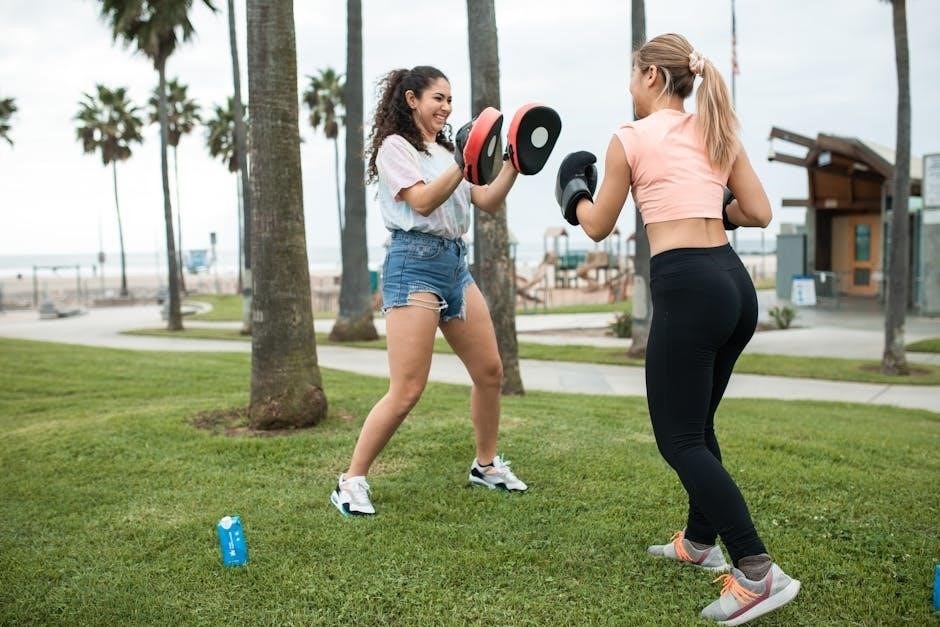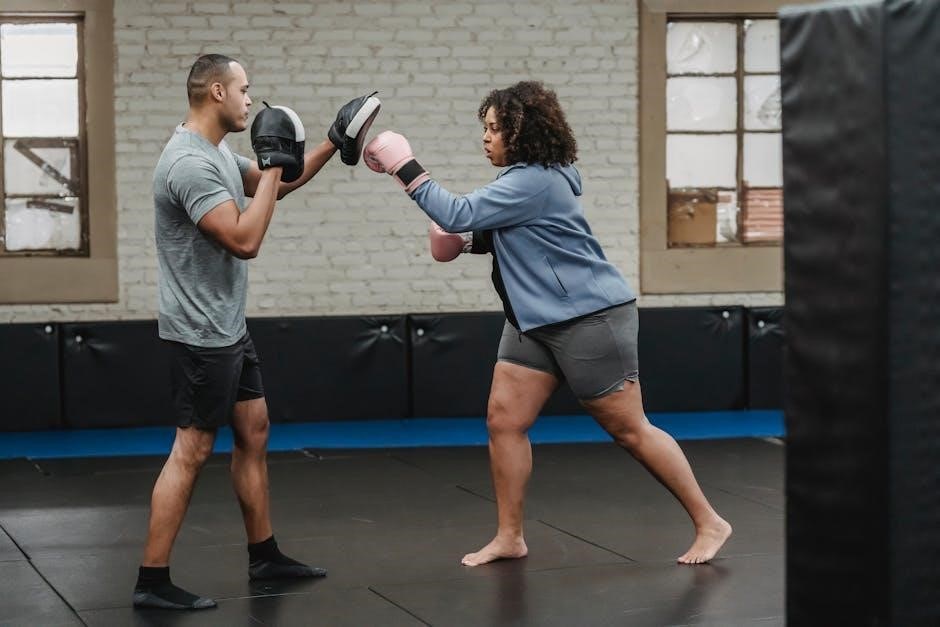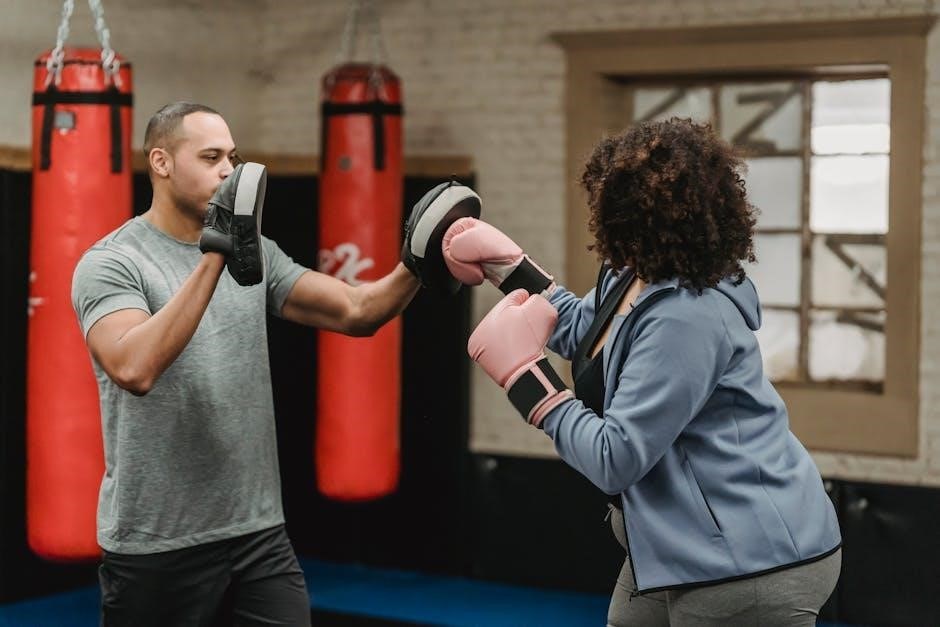
Choosing the right boxing glove size is crucial for protection, comfort, and performance. This guide helps you select the perfect fit based on weight, hand size, and training purpose, ensuring optimal safety and effectiveness in your boxing journey.
Importance of Choosing the Right Boxing Glove Size
Choosing the right boxing glove size is essential for optimal performance, comfort, and safety. Ill-fitting gloves can lead to discomfort, restricted movement, and even injury. Tight gloves may cause poor circulation and limit hand mobility, while loose gloves can fail to provide adequate support, increasing the risk of wrist injuries. Properly sized gloves ensure even distribution of impact force, protecting both your hands and your opponent or training equipment. They also allow for better technique and precision during training or competition. Selecting the wrong size can hinder performance and increase the likelihood of injury, making it crucial to prioritize proper fit when choosing boxing gloves.
Overview of Boxing Glove Sizing Basics
Boxing glove sizing is typically determined by the circumference of the hand and the weight of the gloves. Sizes range from small to extra-large, with measurements based on the knuckles and the back of the hand. Glove sizes are often categorized by weight, ranging from 8 oz to 18 oz, with specific purposes for each weight. Proper sizing ensures a snug fit, preventing excessive movement while allowing dexterity. Different brands may vary slightly, so trying gloves on is recommended. Understanding sizing basics helps boxers choose gloves that balance protection, comfort, and performance. Correct sizing is foundational for effective training and competition.

Understanding Boxing Glove Weight Categories
Boxing gloves are categorized by weight, ranging from 8 oz to 18 oz, with each weight serving specific purposes for training, sparring, or competition, ensuring proper protection and performance.
Common Boxing Glove Weights and Their Uses

Boxing gloves are available in various weights, each designed for specific training purposes. The most common weights are 8-10 oz, 12-14 oz, and 16-18 oz. Lighter gloves (8-10 oz) are typically used for competition and professional fights, emphasizing speed and precision. Medium-weight gloves (12-14 oz) are ideal for bag work, pad drills, and light sparring, offering a balance between protection and responsiveness. Heavier gloves (16-18 oz) are preferred for sparring and heavy bag training, providing maximum hand and wrist protection while absorbing impact. Choosing the right weight ensures optimal performance, safety, and comfort during training or competition.

8-10 oz Gloves: Competition and Training
8-10 oz boxing gloves are the lightest and most popular choice for professional fighters and competitive boxers. These gloves are designed for speed, precision, and minimal weight, making them ideal for competition and high-intensity training. They provide a snug fit, allowing for quick hand movements and accurate punches. While they offer less padding compared to heavier gloves, they are suitable for advanced boxers who prioritize performance over protection. These gloves are often used in pad work, bag drills, and sparring sessions where speed and agility are crucial. However, they are not recommended for beginners, as the lack of padding may lead to hand injuries during heavy impact training.

12-14 oz Gloves: Bag and Pad Work
12-14 oz boxing gloves are ideal for bag work, pad drills, and technical training sessions. Their slightly heavier weight provides additional cushioning and shock absorption, reducing the impact on hands during repetitive striking. These gloves are perfect for boxers who focus on developing power and technique, as they offer a balance between protection and responsiveness. The extra padding also makes them suitable for longer training sessions, ensuring comfort and reducing fatigue. While they are not typically used in professional competitions, they are a favorite among trainers and boxers for rigorous bag and pad exercises. Their durability and support make them a versatile choice for various training scenarios.
16-18 oz Gloves: Sparring and Heavy Bag Training
16-18 oz boxing gloves are designed for sparring and heavy bag training, offering superior protection and cushioning for both hands and opponents. These gloves are ideal for high-impact workouts, as they absorb shock effectively, reducing the risk of injury. The thicker padding makes them suitable for prolonged training sessions and intense bag work. They are also popular for sparring sessions, providing a safe and comfortable experience for participants. These gloves are a favorite among professional and amateur boxers alike, as they strike a balance between durability and performance. Their heavier weight ensures long-lasting use, making them a practical choice for rigorous training regimens.

Factors Determining the Right Glove Size
Hand circumference, body weight, and training purpose are key factors in selecting the right boxing glove size, ensuring comfort, protection, and optimal performance during workouts.
Hand Circumference Measurement
Measuring hand circumference is crucial for determining the right boxing glove size. To measure accurately, wrap a flexible tape measure around the widest part of your hand, just above the knuckles, with your fist slightly clenched. Ensure the tape is snug but not tight. Record the measurement in inches or centimeters. Most boxing gloves range from small to extra-large, corresponding to hand circumferences of 6-10 inches. Proper fit ensures padding aligns with knuckles, providing protection during strikes. Different brands may vary slightly, so always refer to the manufacturer’s size chart. Accurate measurement helps prevent overly tight or loose gloves, which can hinder performance or cause discomfort;
Body Weight and Glove Size Correlation
Body weight often correlates with boxing glove size, as heavier individuals tend to have larger hands. Generally, boxers weighing under 120 lbs (54 kg) may prefer smaller gloves (8-10 oz), while those over 150 lbs (68 kg) may opt for larger sizes (16-18 oz). This correlation helps ensure adequate padding and protection. However, it’s not a strict rule, as hand size can vary independently of body weight. Combining body weight with hand circumference provides a more accurate fit. For example, a 140 lbs (63 kg) boxer with smaller hands might choose 12 oz gloves, while a 130 lbs (59 kg) boxer with larger hands might prefer 14 oz. Always consider both factors for the best fit.
Training Purpose and Glove Size Selection
The training purpose significantly influences the choice of boxing glove size. For bag and pad work, lighter gloves (12-14 oz) are ideal, as they allow for speed and precision. Sparring requires heavier gloves (16-18 oz) to ensure safety and reduce impact. Competition gloves (8-10 oz) are lightweight for performance but meet regulations. Training gloves (14-16 oz) offer a balance for general use. The activity determines the needed padding and weight, so matching the glove size to the training type is essential for optimal performance and safety. Always select gloves that align with your specific training goals to maximize effectiveness and protection.
Boxing Glove Size Chart and Measurement Guide
A boxing glove size chart typically ranges from small to extra-large, based on hand circumference. Proper measurement ensures a snug, protective fit for optimal performance.

Hand Measurement Techniques
Measuring your hand correctly is crucial for selecting the right boxing glove size. Wrap a flexible tape measure around the widest part of your knuckles, with your hand relaxed and fingers extended. Ensure the tape is snug but not too tight. This measurement, typically in inches, will guide you to the appropriate glove size. Most gloves range from small to extra-large, corresponding to specific hand circumferences. Accurate measurement ensures a proper fit, preventing discomfort or inadequate protection during training. Consistency is key, so always measure the same way for reliable results.
Weight-to-Size Conversion
Weight-to-size conversion in boxing gloves involves matching the glove’s weight to its intended use and the wearer’s hand size. Lighter gloves (8-10 oz) are designed for smaller hands and competitive use, while heavier gloves (16-18 oz) suit larger hands and sparring. The conversion isn’t linear, as materials and padding vary. Generally, 12 oz gloves fit medium-sized hands, 14 oz for large, and 16 oz for extra-large. This guide helps ensure proper fit and protection, balancing comfort with functionality. Always consider personal hand size and training needs when selecting gloves.
Size Recommendations by Body Weight
Body weight plays a significant role in determining the ideal boxing glove size. Generally, lighter boxers (under 120 lbs) opt for smaller gloves (8-12 oz), while heavier individuals (150+ lbs) prefer larger sizes (14-18 oz). A 120-150 lb range typically uses 12-14 oz gloves, balancing protection and mobility. However, this is a general guide, as hand size and training purpose also influence the choice. For example, a 140 lb boxer with larger hands might prefer 14 oz gloves for sparring, while a 130 lb boxer with smaller hands might choose 12 oz. Always consider both weight and hand circumference for the best fit.

Specialized Gloves for Different Training Needs
Specialized boxing gloves cater to specific training needs, ensuring optimal performance and protection. Bag gloves prioritize padding for heavy bag work, while sparring gloves emphasize injury prevention. Competition gloves are lightweight for speed and precision, adhering to regulations. Each type is tailored to its intended use, balancing support, impact absorption, and durability.
Bag Gloves vs. Sparring Gloves
Bag gloves and sparring gloves are designed for specific training purposes, with distinct differences in weight, padding, and functionality. Bag gloves are lighter, typically ranging from 8-12 oz, and are optimized for speed and precision during bag or pad work. They have less padding, allowing for better feel and control when striking. In contrast, sparring gloves are heavier, usually 14-16 oz, and prioritize protection during partner drills or sparring. They feature thicker padding to absorb impact and reduce injury risk. While bag gloves focus on offensive techniques, sparring gloves balance offense and defense. Choosing the right type ensures optimal performance and safety for the intended training activity.
Competition Gloves vs. Training Gloves
Competition gloves and training gloves serve distinct purposes, impacting size and weight selection; Competition gloves are lighter, typically 8-10 oz, designed for speed and precision during fights. They have less padding to allow for tighter fist formation and quicker movements. Training gloves, usually 12-16 oz, prioritize hand protection and durability. Thicker padding absorbs impact during heavy bag work or sparring. The choice between them depends on the activity: lighter for competition, heavier for training. Proper selection ensures performance and safety, avoiding injuries or poor technique. Understanding these differences helps boxers optimize their gear for specific scenarios, enhancing both effectiveness and comfort during workouts or matches.
- Competition gloves: 8-10 oz, less padding, for fights.
- Training gloves: 12-16 oz, more padding, for practice.
Material Differences and Their Impact on Size
The material of boxing gloves significantly impacts their size and fit. Gloves are typically made from leather, synthetic leather, or vinyl, each offering different benefits. Leather gloves are durable and provide a snug fit, often requiring a slightly tighter size initially as they break in; Synthetic materials, such as vinyl or polyurethane, are lighter and easier to clean but may lack the same moldability as leather. The material’s thickness and flexibility can affect how the glove conforms to the hand, influencing the perceived size. Choosing the right material ensures optimal comfort and protection, making it essential to consider when selecting a glove size for training or competition.
Common Mistakes in Choosing Glove Size
Common mistakes include neglecting proper hand measurements, prioritizing style over fit, and selecting gloves based on brand rather than training needs or hand size.
Overlooking Hand Circumference
One of the most common mistakes when selecting boxing gloves is neglecting to measure hand circumference. Proper fit is essential for performance and safety, as ill-fitting gloves can lead to discomfort, reduced dexterity, and even injury. Hand circumference determines how the gloves will conform to your fists, ensuring adequate padding and support. Many boxers rely solely on weight categories or general sizes without considering their hand size, which can result in gloves that are too tight or too loose. To avoid this, always measure around the widest part of your hand, including the knuckles, to ensure an accurate fit. Proper sizing enhances both training efficiency and protection.
Incorrect Weight Selection for Training Type
One of the most common mistakes in choosing boxing gloves is selecting the wrong weight for the specific training type. For example, using lightweight gloves (8-10 oz) for heavy sparring can increase the risk of injury, as they lack sufficient padding to protect both the wearer and their partner. Conversely, using heavy gloves (16-18 oz) for speed drills or bag work can hinder performance by reducing hand speed and agility. It’s essential to match glove weight to the activity—lighter for technique and competition, heavier for sparring and impact training. Always consult a size chart or seek expert advice to avoid this error.
Ignoring the Role of Hand Wraps
One common mistake fighters make is overlooking the importance of hand wraps when selecting boxing gloves. Hand wraps provide essential support and protection, directly impacting how gloves fit and perform. Neglecting to consider their role can lead to improper sizing, as wraps add bulk to the hands. Without accounting for this, gloves may feel too tight or restrictive, hindering movement and comfort during training; Additionally, improper fit can compromise the protection offered by the gloves, increasing the risk of injury. Always ensure to try on gloves with your preferred hand wraps to achieve the best fit and performance. This step is crucial for both safety and effectiveness in training or competition.
and Final Tips
Selecting the right boxing gloves is crucial for performance and safety. Consider fit, weight, and training purpose. Try them on to ensure comfort and proper fit. Regular maintenance ensures longevity.
Key Takeaways for Selecting the Right Glove Size
Choosing the right boxing glove size is crucial for performance, comfort, and safety. Always measure your hand circumference accurately and consider your training purpose. Lighter gloves (8-10 oz) are ideal for competitions, while heavier ones (16-18 oz) suit sparring. Match glove weight to your activity to ensure proper protection. Don’t overlook the role of hand wraps, as they affect fit. Try gloves on before buying if possible, and prioritize quality materials for durability. Remember, the right size enhances technique, reduces injury risk, and improves overall training efficiency. By combining these factors, you’ll find gloves that meet your needs and elevate your boxing experience.

Importance of Trying Gloves On
Trying boxing gloves on before purchasing is crucial to ensure a proper fit, as it directly impacts performance and safety. A snug yet comfortable fit prevents restricted movement and provides adequate support. Ill-fitting gloves can lead to discomfort, reduced dexterity, or even injury. Different brands may vary slightly in sizing, so trying them on allows you to assess how they feel. Pay attention to how your hands sit inside the gloves, ensuring your fingers can move freely without feeling cramped. Additionally, consider wearing hand wraps to simulate real training conditions. This step ensures the gloves meet your specific needs, offering both protection and mobility. It’s a simple yet vital step in making the right choice.
Maintenance and Longevity of Boxing Gloves

To ensure the longevity of your boxing gloves, proper maintenance is essential. Regularly clean the exterior with a mild soap solution and allow them to air dry. Stuffing gloves with newspaper after use can absorb moisture and prevent odor buildup. Store them in a cool, dry place, avoiding direct sunlight. Avoid leaving them in a gym bag, as this can foster bacterial growth. Always allow gloves to dry completely between training sessions. Use hand wraps to protect the interior from sweat and oils. Rotate between pairs during training to evenly distribute wear. Replace gloves when they show significant signs of deterioration or develop a persistent odor.